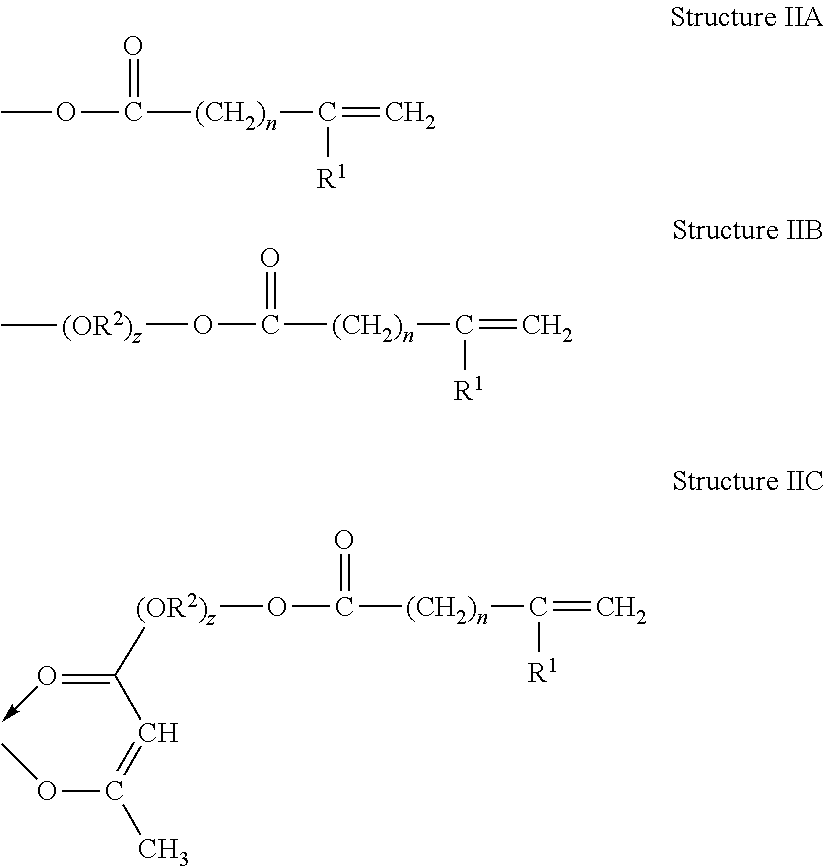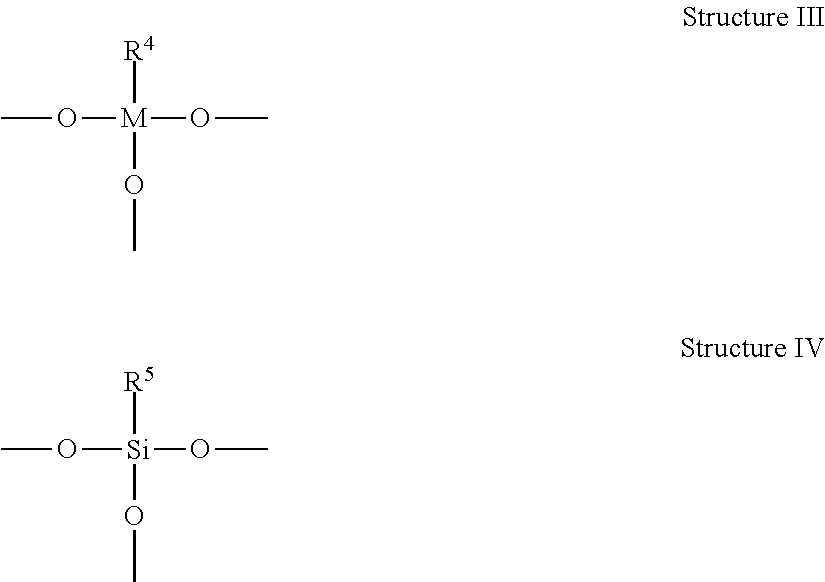Metal-Containing Compositions and Method of Making Same
a composition and metal technology, applied in the field of metal-containing compositions, can solve the problems of difficult modification of refractive index, limited practical utility of inorganic particles in boosting refractive index, and low intensity of transmitted light, and achieve excellent optical clarity and shelf life stability
- Summary
- Abstract
- Description
- Claims
- Application Information
AI Technical Summary
Benefits of technology
Problems solved by technology
Method used
Image
Examples
example 1
[0143]An ethyl acetate solution of urethane acrylate oligomer, U1, as prepared in Preparative Example 1 (1.32 g) was added to a 2-dram amber vial containing zirconyl dimethacrylate, Catalog No. CXZR051 from Gelest, Inc (0.09 g), and 1-[4-(phenylthio) phenyl]-2-(O-benzoyloxime) 1,2-octanedione, Irgacure OXE-01 from Ciba Specialty Chemicals (0.04 g). Additional ethyl acetate (0.74 g) was added to adjust the concentration to 40% solids. The resulting mixture was homogeneous and clear after 5 minutes of agitation. The clear solution was filtered through a 0.2 μm PTFE syringe filter to remove any extraneous impurities such as dust particles. The solution was coated onto a Luminor T PET film from Toray (75 μm thick) with a wire-wound coater (3 mil diameter), Catalog No. AR-4103 from BYK Gardner to a wet film thickness of about 5 μm and dried for 120 seconds at 80° C. in an oven. This dried film was cured by a Blak-ray UV lamp Model 100 AP and then tested to determine its scratch resistanc...
example 2
[0146]An ethyl acetate solution of urethane acrylate oligomer, U1, as prepared in Preparative Example 1 (1.40 g) and a solution of zirconyl dimethacrylate as prepared in Preparative Example 4 (0.72 g) were added to a 2-dram amber vial containing 1-hydroxy-cyclohexyl-phenyl-ketone, Irgacure 184 from Ciba Specialty Chemicals (0.06 g), and bis(2,4,6-trimethylbenzoyl)-phenylphosphineoxide, Irgacure 819 from Ciba Specialty Chemicals (0.01 g). Additional ethyl acetate (1.74 g) was added to adjust the concentration to 40% solids. The resulting mixture was homogeneous and clear after 5 minutes of agitation. The homogeneous solution was filtered through a 0.2 μm PTFE syringe filter to remove any extraneous impurities such as dust particles. The solution was coated onto a Luminor T PET film from Toray (75 μm thick) with a wire-wound coater (3 mil diameter), Catalog No. AR-4103 from BYK Gardner to a wet film thickness of about 5 μM and dried for 120 seconds at 80° C. in an oven. This dried fil...
example 3
[0148]An ethyl acetate solution of urethane acrylate oligomer, U1, as prepared in Preparative Example 1 (0.20 g) and solution of zirconyl dimethacrylate as prepared in Preparative Example 4 (2.14 g) were added to a 2-dram amber vial containing 1-hydroxy-cyclohexyl-phenyl-ketone, Irgacure 184 from Ciba Specialty Chemicals (0.06 g). Additional ethyl acetate (0.69 g) was added to adjust the concentration to 39% solids. The resulting mixture was homogeneous and clear after 5 minutes of agitation. The clear solution was filtered through a 0.2 μm PTFE syringe filter to remove any extraneous impurities such as dust particles. The solution was coated onto a Luminor T PET film from Toray (75 μm thick) with a wire-wound coater (3 mil diameter), Catalog No. AR-4103 from BYK Gardner to a wet film thickness of about 5 μm and dried for 120 seconds at 80° C. in an oven. This dried film was cured by a Blak-ray UV lamp Model 100 AP and then tested to determine its scratch resistance, hardness, and c...
PUM
| Property | Measurement | Unit |
|---|---|---|
| temperature | aaaaa | aaaaa |
| photosensitive | aaaaa | aaaaa |
| Structure | aaaaa | aaaaa |
Abstract
Description
Claims
Application Information
 Login to View More
Login to View More - R&D
- Intellectual Property
- Life Sciences
- Materials
- Tech Scout
- Unparalleled Data Quality
- Higher Quality Content
- 60% Fewer Hallucinations
Browse by: Latest US Patents, China's latest patents, Technical Efficacy Thesaurus, Application Domain, Technology Topic, Popular Technical Reports.
© 2025 PatSnap. All rights reserved.Legal|Privacy policy|Modern Slavery Act Transparency Statement|Sitemap|About US| Contact US: help@patsnap.com



